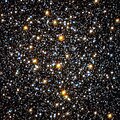File:NGC 6362 globular cluster HST.jpg

原始文件 (3,061 × 3,061像素,文件大小:6.78 MB,MIME类型:image/jpeg)
摘要
| 描述NGC 6362 globular cluster HST.jpg |
Polski: Gromada kulista NGC 6362. Zdjęcie wykonane przez Teleskop Hubble'a. English: NGC 6362 - An unexpected population of young-looking stars
The NASA/ESA Hubble Space Telescope offers an impressive view of the centre of globular cluster NGC 6362. The image of this spherical collection of stars takes a deeper look at the core of the globular cluster, which contains a high concentration of stars with different colours. Tightly bound by gravity, globular clusters are composed of old stars, which, at around 10 billion years old, are much older than the Sun. These clusters are fairly common, with more than 150 currently known in our galaxy, the Milky Way, and more which have been spotted in other galaxies. Globular clusters are among the oldest structures in the Universe that are accessible to direct observational investigation, making them living fossils from the early years of the cosmos. Astronomers infer important properties of globular clusters by looking at the light from their constituent stars. For many years, they were regarded as ideal laboratories for testing the standard stellar evolution theory. Among other things, this theory suggests that most of the stars within a globular cluster should be of a similar age. Recently, however, high precision measurements performed in numerous globular clusters, primarily with the Hubble Space Telescope, has led some to question this widely accepted theory. In particular, certain stars appear younger and bluer than their companions, and they have been dubbed blue stragglers. NGC 6362 contains many of these stars. Since they are usually found in the core regions of clusters, where the concentration of stars is large, the most likely explanation for this unexpected population of objects seems to be that they could be either the result of stellar collisions or transfer of material between stars in binary systems. This influx of new material would heat up the star and make it appear younger than its neighbours. NGC 6362 is located about 25 000 light-years from Earth in the constellation of Ara (The Altar). British astronomer James Dunlop first observed this globular cluster on 30 June 1826. This image was created combining ultraviolet, visual and infrared images taken with the Wide Field Channel of the Advanced Camera for Surveys and the Wide Field Camera 3. An image image of NGC 6362 taken by the MPG/ESO 2.2-metre telescope will be published by the European Southern Observatory on Wednesday. See it on www.eso.org from 12:00 on 31 October. Credit: ESA/Hubble & NASA About the Image Id: potw1244a Type: Observation Release date: 29 October 2012, 10:00 Size: 3061 x 3061 px About the Object Name: NGC 6362 Type: • Milky Way : Star : Grouping : Cluster : Globular Distance: 25000 light years Colours & filters Band Wavelength Telescope Ultraviolet U 336 nm Hubble Space Telescope WFC3 Optical R 625 nm Hubble Space Telescope ACS Infrared I 814 nm Hubble Space Telescope ACS. |
| 日期 | |
| 来源 | http://www.spacetelescope.org/images/potw1244a/ |
| 作者 | ESA/Hubble & NASA |
| 授权 (二次使用本文件) |
http://www.spacetelescope.org/copyright/ |
| 其他版本 |
 |
许可协议
- 您可以自由地:
- 共享 – 复制、发行并传播本作品
- 修改 – 改编作品
- 惟须遵守下列条件:
- 署名 – 您必须对作品进行署名,提供授权条款的链接,并说明是否对原始内容进行了更改。您可以用任何合理的方式来署名,但不得以任何方式表明许可人认可您或您的使用。
说明
此文件中描述的项目
描绘内容
知识共享署名3.0未本地化版本 简体中文(已转写)
29 10 2012
文件历史
点击某个日期/时间查看对应时刻的文件。
| 日期/时间 | 缩略图 | 大小 | 用户 | 备注 | |
|---|---|---|---|---|---|
| 当前 | 2012年11月4日 (日) 14:36 |  | 3,061 × 3,061(6.78 MB) | Fabian RRRR | higher resolution: source (direct link) http://www.spacetelescope.org/images/potw1244a/ |
| 2012年11月3日 (六) 12:17 |  | 1,280 × 1,280(715 KB) | Winiar | User created page with UploadWizard |
文件用途
以下页面使用本文件:
全域文件用途
以下其他wiki使用此文件:
- el.wikipedia.org上的用途
- en.wikipedia.org上的用途
- fr.wikipedia.org上的用途
- ht.wikipedia.org上的用途
- nl.wikipedia.org上的用途
- pl.wikipedia.org上的用途
元数据
此文件中包含有扩展的信息。这些信息可能是由数码相机或扫描仪在创建或数字化过程中所添加。
如果此文件的源文件已经被修改,一些信息在修改后的文件中将不能完全反映出来。
| 图像标题 |
|
|---|---|
| 在线著作权声明 | |
| 来源 | ESA/Hubble |
| 提供者 | ESA/Hubble & NASA |
| 使用条款 |
|
| 简短标题 |
|
| 数据生成日期时间 | 2012年10月29日 (一) 10:00 |
| 著作权状况 | 著作权状况未设置 |
| 关键词 | NGC 6362 |
| 联系信息 |
http://www.spacetelescope.org/ Karl-Schwarzschild-Strasse 2 Garching bei München, , D-85748 Germany |

